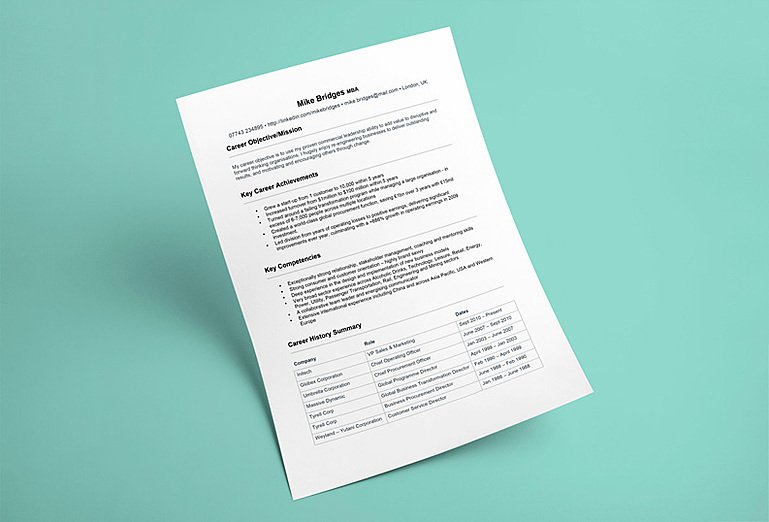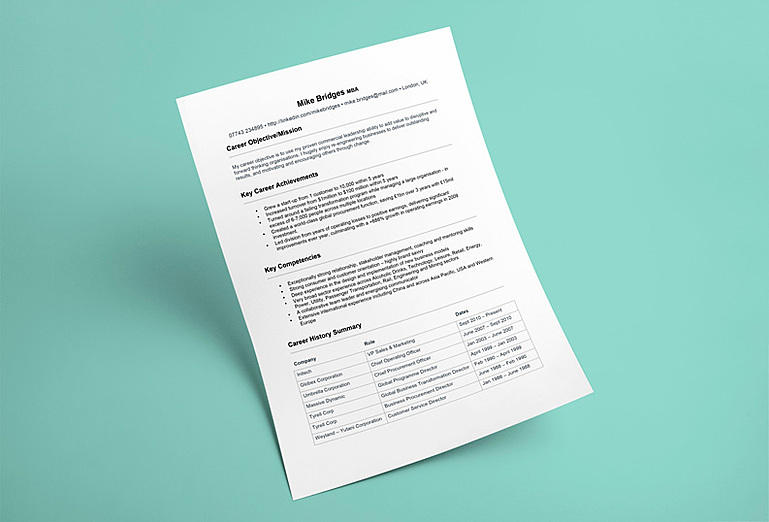A Winning Senior Executive CV Template [Video]
Written by Andrew MacAskill on Feb. 28, 2019

CVs are a difficult topic as people tend to get a lot of conflicting advice from either friends or colleagues or so-called professionals in the space around how it should be structured and the things to watch out for.
We're quite lucky. We've got in the region of 250,000 Executive CVs in our global database so we've seen everything from the very good, to the not so good. What we've managed is do is form a view, and distill this down into a template, which we think will really be beneficial to anybody about to go to market or in the middle of any sort of job search activity.
In this video, I'm going to talk you through that template. A template should be underpinned by two key rules, so I want to share those rules first to get some more context around why we selected this particular structure.
- The First Rule Is What We Call The Ten Second Rule
You may have read before that most people don't take longer than ten seconds to review a CV. Generally our audiences at the senior executive level are very busy people who will be skimming and looking for specific things in order to evaluate whether you are right or not right for an initial screening or interview process. We've got to be really aware of this Ten Second Rule.
- The Second Rule Is All About Audience
We've got to make sure that our document appeals to a broad audience. It won't necessarily be a highly technical person reviewing your CV. It may well be that your CV is reviewed by a headhunter or researcher or HR Department before the Board or the CEO or MD get to view it, so we've got to make sure that our CV is broad and wide reaching in it's appeal.
CV Structure - Name, Contact Details And Location
Onto the actual structure itself then. As with most things, simplicity is key here as clarity, which is also very important. Of course at the top goes your name (I'm sure we can get that right!).
Rather than having a huge education section, we would recommend you just put the letters after your name if you have any academic qualifications at the top of the CV, and have a separate smaller education section at the end of the CV . Thinking back to the Ten Second Rule, the image you need to keep in mind is that if the first page of your CV was to blow down the street and a perspective employer was to pick up that page, they should be able to tell from that page alone what your career is all about.
The first page on it's own should stand up as a document while the other pages are supplementing information that builds out more detail around it. You also need to make sure you're easily contactable through a number of means so it's very important that you've got a phone number there and we'd also highly recommend that you have a hyperlink to your LinkedIn profile. It's also really important that you also detail your location at this point, because a number of search algorithms used by recruitment databases will use location as a key factor in the people that they select to approach about opportunities.
Career Objective or Mission Statement
The next section is where a lot of experienced people who've achieved a lot start to go wrong. Senior executives tend to have a huge, cumbersome personal profile section, which is a whole bunch of text that takes up at least a third to half of the first page talking about them, who they are, and what they're about.
It tends to be a little generic... I'm a dynamic leader, proven executive, seasoned professional... whatever cliché you want to use. Our experience is that clients, headhunters and decision-makers in the career process don't tend to read those. Sadly as a result a lot of good stuff doesn't get picked up because it's lost in the mire of all that text. So rather than a block of text, distill your personal profile down to either a career objective or a career mission. It could be something as simple as "my career objective is to use my proven commercial leadership ability to add value to a forward-thinking organisation". It's a statement of intent, it's punchy and it shows a really good focus.
Career Achievements
Once you've got that mission or objective in place at the top of the CV, our next recommendation is that you pull out six to eight absolute key career achievements. These are the six to eight things that you're most proud of and that you'd want a prospective employer to see first if they were considering your application. Make them really compelling. I see a lot of people who have career achievements that are lost on page three or four, which could be really good, but are never seen. We really want to be hitting people early with what you've done, what you've achieved, and what you're proud of, to get some really good positivity and momentum going in the mind of the person that's looking through this document.
Competencies
Coming back to our point about broad audience the next section to include is six to eight technical and behavioral competencies. Bear in mind that a lot of people reviewing these CVs will actually have a job description with a list of Competencies they'll be looking to marry up. By listing your key competencies in this way you're making it very easy for them to select you as a preferential candidate. The types of things here would be stakeholder management, influencing, leadership, adaptability, and more technical things if you're in a more technical field.
Career History Summary
Once we've got to the bottom third of the first page, you need to create a grid. This grid can be titled Career History or Career Journey or something along those lines and it will have three simple sections:
Company | Role | Dates
You then simply list out the companies you've worked for, what roles you've had with those companies, and the dates you were there. The reason why you're doing this is because it gives people a really quick, easy snapshot in terms of your career journey, how quickly you've progressed, the sort of tenure that you've shown in roles, and also serves as an index to the rest of the CV document. As a recruiter, I can then quickly look down this company area, and say... oh okay, that particular tenure here is of interest to us in the context of this role, let's flick over a few pages and read more about it. Crucially though, as an executive candidate you are sign posting your CV so that the reviewer can decide where to go as opposed to them having to wade through lots of text that to get to the good stuff.
By briefly summarising your previous job titles, you are also increasing the chances of being found in a database search by a recruitment company for a relevant job. Most recruiters will narrow down their search by job title, but these can sometimes get missed by the search algorithm if the job titles are buried in a bunch of other text. Briefly and clearly summarising your job titles on page one makes it easier for the search tool to see that you are a potential match.
The Rest Of Your CV
Without a doubt the quality and clarity of the first page of your CV will be a key factor in determining whether you are going to be the right kind of person for a role. Beyond the first page we suggest you have three sections:
- Full Career History
This is where you can enter more details about each of the positions you have held and what your key achievements and responsibilities are. As a reviewer, I will use this section to explore particular tenures that are of interest to me and the role you are being put forward for.
- Interests
It's good to include some short personal information about yourself on your CV. Often hiring managers will take a quick look at this section to see what kind of person you are and what your passions are in life. It's also a good way for a hiring manager to spark up a casual conversation so make sure you're able to expand on anything you put down!
- Qualifications
It's good practice to include your full list of qualifications, certifications and membership of any societies on your CV too. For senior executive positions, educational background is never as important as experience and expertise but it is still worth including this section.
What Next?
Hopefully the senior executive CV template we've laid our here makes sense. When somebody is looking at this, they will get a really good feel for how driven you are, and how objective your mission is. You're hitting them with achievements which are good and they’ll be feeling very positive about you. You've got all the Competencies they are looking for, and your document is optimised to give you the best chance of being found through recruitment search algorithms. As a hiring manager or recruiter, we'd have a really good feel from you in one page of your career journey today.
Download Your Own Senior Executive CV Template
If you would like to lay out your CV in the same structure and style as we have described in this article then download our senior executive CV template or use the link below. Once you've completed it, don't forget to submit it to our executive database using this link.
